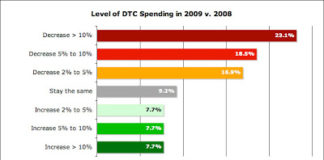I attended the recent seminar entitled “Are You Building Brands…Or Relationships?”, which was hosted by Lathian Systems, Inc., a provider of eDetailing and other web-based programs for pharmaceutical marketing.
I will be reviewing in more detail a couple of the presentations from this seminar in an upcoming issue of Pharma Marketing News. Here, however, I’d like to focus on just a few things that I learned specifically related to ROI or Return on Investment for eDetailing programs, especially compared to ROI for direct-to-consumer (DTC) advertising.
Let’s look at some pharmaceutical consumer and physician promotion ROI numbers.
Keep in mind that the pharmaceutical industry spends massive amounts of money on promoting to consumers and physicians and all this money has spawned an ad and marketing “palace industry” — as opposed to a “cottage industry” — that spends an awful lot of time, effort, and money of its own to defend the effectiveness of the products and services it offers its pharmaceutical clients. Therefore, it is quite difficult to reach consensus on ROI and the bullshit level of many estimates is likely to be very high.
DTC ROI
Although there is much controversy surrounding DTC ROI, most published data on ROI for DTC show positive results.
On one hand, one industry expert estimated that ROI for DTCA (direct-to-consumer advertising) is in the range of $1.60 to $2.00 per every dollar invested and some estimates are as high as $4.00 per dollar invested. (See “Key Issues Facing DTC Marketers in 2004“).
On the other hand, a study by Dartmouth College concluded that the overall median ROI for DTC was only $0.19 and several brands had negative ROIs! “DTC ROI ranged up to $1.37, depending on brand size/launch date,” was the best it could say about DTC (see the “ROI Analysis of Pharmaceutical Promotion” or “RAPP Study“).
Needless to say, the RAPP study, which was sponsored by the Association of Medical Publications (not an unbiased entity), is often criticized by pharmaceutical marketers. An IMS study, in particular, countered the RAPP study using a different methodology and concluded that “Seventy percent of the brands analyzed have an ROI in excess of $1.50 for each dollar invested; 35 percent were in excess of $2.50. The best performing brand in the study yielded an ROI of $6.50 per dollar invested.” (See “DTC at the Crossroads: A Direct’ Hit…or Miss?“)
OK, let’s split the difference between RAPP’s best number of $1.37 and IMS’s average of $2.00 and use $1.68 our estimate for DTC ROI.
Physician Detailing ROI
The same RAPP Study concluded that the overall ROI for physician (traditional detailing) was $1.72 (ranging from $1.27 to $10.29 depending on brand size and launch date). I don’t have any other numbers for traditional detailing ROI.
eDetailing ROI
Sally Schehr, principal at IMS Health Management Consulting, presented data at the Lathian seminar for one eDetailing case showing ROI to be $2.48. The analysis was done for a Lathian eDetailing program, but IMS has numbers for other programs as well. I will report on this in an upcoming Pharma Marketing News article.
ROI Summary
- DTC = $1.68
- Traditional Detailing = $1.72
- eDetailing = $2.48
So, Why Isn’t More Money Being Spent on eDetails?
If the one eDetailing case study proves to be average, then it’s difficult to understand why pharmaceutical brand managers do not spend more money on eDetailing (and less on DTC).
It’s not that they doubt that eDetailing works. Monique Levy, Senior Analyst at Jupiter Research, presented results at the Lathian seminar from a survey of pharmaceutical executives that her firm conducted in August 2004. Only 16% of the respondents indicated that “low ROI” was a barrier to increasing spending on eDetailing.
What 61% of execs in the survey wanted, however, was proof of ROI. This seems just what IMS is offering.
Another barrier to increasing use of eDetailing that Levy mentioned was the strong traditional sales culture at pharmaceutical companies. Forty-eight percent (48%) of survey respondents cited this as a barrier to eDetailing.
“There is a dichotomy between sales and marketing at pharmaceutical companies,” said Levy. “Sales doesn’t take marketing seriously. It’s often like two different worlds.”
Drop the “eDetailing” Moniker
My suggestion for eDetailing advocates is to come up with another name for what they offer.
I always hear advocates emphasize that eDetailing is meant to supplement sales reps, not replace them. Bullshit! And the reps know it is bullshit. The moniker “eDetailing” will always pit the sales rep against the computer geek (and marketer enamored by geeky solutions). With a name like “e-detailing” how can a rep NOT believe his or her livelihood is threatened by technology?
So drop the name. It stinks!
I credit Lathian Systems for re-positioning themselves as “evolving to educate” (see “Beyond the eDetail: Evolving to Educate“).
Sales reps want to sell, not necessarily to educate. Therefore, they should not be challenged by “e-Educating” as much as they seemingly are by “e-Detailing.”
Perhaps “e-Promotion” might be the best alternative to “e-Detailing;” it allows the distinction between “product education” (promotion) and truly “unbiased” education such as CME.
Whatever you call it, physicians want both kinds of education and they want it at their own convenience delivered in their homes via the Internet.
It’s also clear that reps are not good at delivering either kind of education (see “Give Docs What They Want“). Furthermore, reps would probably welcome the opportunity to relinquish the “educator” role and stick to the selling, which they are trained to do, constantly admonished to do, and rewarded well for doing.









![6 Digital Tools at the Center of Healthcare Digitalization [INFOGRAPHIC]](http://ec2-54-175-84-28.compute-1.amazonaws.com/pharma-mkting.com/wp-content/uploads/2021/04/6DigitalTools_600px-100x70.jpg)




